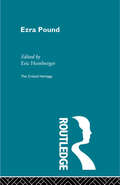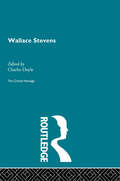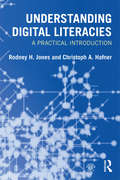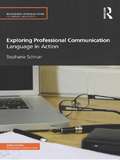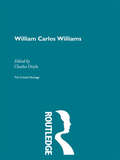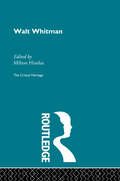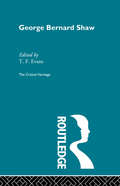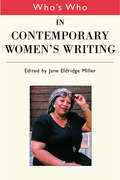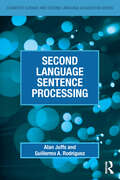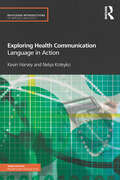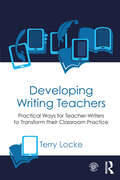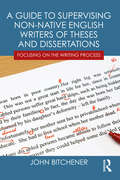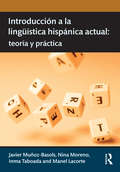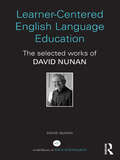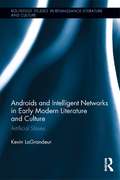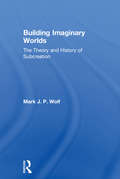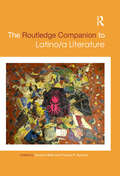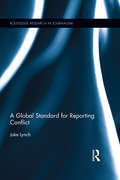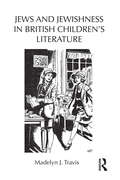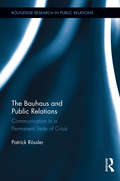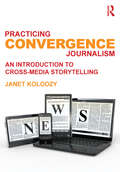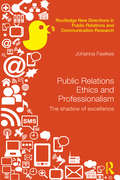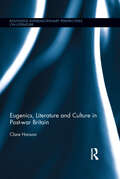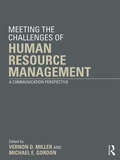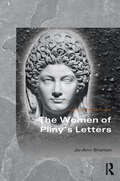- Table View
- List View
Ezra Pound (Collected Critical Heritage Ser. #Series 2)
by Eric HombergerThis set comprises 40 volumes covering nineteenth and twentieth century European and American authors. These volumes will be available as a complete set, mini boxed sets (by theme) or as individual volumes. This second set compliments the first 68 volume set of Critical Heritage published by Routledge in October 1995.
Wallace Stevens: The Critical Heritage (Critical Heritage Ser.)
by Charles DoyleThis set comprises of 40 volumes covering nineteenth and twentieth century European and American authors. These volumes will be available as a complete set, mini boxed sets (by theme) or as individual volumes. This second set compliments the first 68 volume set of Critical Heritage published by Routledge in October 1995.
Understanding Digital Literacies: A Practical Introduction
by Rodney H. Jones Christoph A. HafnerAssuming no knowledge of linguistics, Understanding Digital Literacies provides an accessible and timely introduction to new media literacies. It supplies readers with the theoretical and analytical tools with which to explore the linguistic and social impact of a host of new digital literacy practices. Each chapter in the volume covers a different topic, presenting an overview of the major concepts, issues, problems and debates surrounding the topic, while also encouraging students to reflect on and critically evaluate their own language and communication practices. Features include: coverage of a diverse range of digital media texts, tools and practices including blogging, hypertextual organisation, Facebook, Twitter, YouTube, Wikipedia, websites and games an extensive range of examples and case studies to illustrate each topic, such as how blogs have affected our thinking about communication, how the creation and sharing of digital images and video can bring about shifts in social roles, and how the design of multiplayer online games for children can promote different ideologies a variety of discussion questions and mini-ethnographic research projects involving exploration of various patterns of media production and communication between peers, for example in the context of Wikinomics and peer production, social networking and civic participation, and digital literacies at work end of chapter suggestions for further reading and links to key web and video resources a companion website providing supplementary material for each chapter, including summaries of key issues, additional web-based exercises, and links to further resources such as useful websites, articles, videos and blogs. This book will provide a key resource for undergraduate and graduate students studying courses in new media and digital literacies.
Exploring Professional Communication: Language in Action (Routledge Introductions to Applied Linguistics)
by Stephanie SchnurrRoutledge Introductions to Applied Linguistics is a series of introductory level textbooks covering the core topics in Applied Linguistics, primarily designed for those beginning postgraduate studies, or taking an introductory MA course as well as advanced undergraduates. Titles in the series are also ideal for language professionals returning to academic study. The books take an innovative ‘practice-to-theory’ approach, with a 'back-to-front' structure. This leads the reader from real-world problems and issues, through a discussion of intervention and how to engage with these concerns, before finally relating these practical issues to theoretical foundations. Additional features include tasks with commentaries, a glossary of key terms, and an annotated further reading section. Exploring Professional Communication provides an accessible overview of the vast field of communication in professional contexts from an applied linguistics perspective. It explores the nature of professional communication by discussing various fundamental topics relevant for an understanding of this area. The book is divided into eight chapters, each dealing with a specific area of professional communication, such as genres of professional communication, identities in the workplace, and key issues of gender, leadership and culture. Although the book’s main approach to professional communication is an applied linguistics one, it also draws on insights from a range of other disciplines. Throughout, Stephanie Schnurr takes an interactive approach that is reflected in the numerous examples of authentic discourse data, from a variety of written and spoken contexts. Exploring Professional Communication is critical reading for postgraduate and upper undergraduate students of applied linguistics and communication studies.
William Carlos Williams
by Charles DoyleThis set comprises of 40 volumes covering nineteenth and twentieth century European and American authors. These volumes will be available as a complete set, mini boxed sets (by theme) or as individual volumes. This second set compliments the first 68 volume set of Critical Heritage published by Routledge in October 1995.
Walt Whitman
by Milton HindusThis set comprises of 40 volumes covering nineteenth and twentieth century European and American authors. These volumes will be available as a complete set, mini boxed sets (by theme) or as individual volumes. This second set compliments the first 68 volume set of Critical Heritage published by Routledge in October 1995.
George Bernard Shaw
by T. F. EvansThis set comprises 40 volumes covering nineteenth and twentieth century European and American authors. These volumes will be available as a complete set, mini boxed sets (by theme) or as individual volumes. This second set compliments the first 68 volume set of Critical Heritage published by Routledge in October 1995.
Who's Who in Contemporary Women's Writing (Who's Who Ser.)
by Jane Eldridge MillerUnique in its breadth of coverage, Who's Who in Contemporary Women's Writing is a comprehensive, authoritative and enjoyable guide to women's fiction, prose, poetry and drama from around the world in the second half of the twentieth century. Over the course of 1000 entries by over 150 international contributors, a picture emerges of the incredible range of women's writing in our time, from Toni Morrison to Fleur Adcock- all are here. This book includes the established and well-loved but also opens up new worlds of modern literature which may be unfamiliar but are never less than fascinating.
Second Language Sentence Processing (Cognitive Science and Second Language Acquisition Series)
by Alan Juffs Guillermo A. RodríguezThis addition to the Cognitive Science and Second Language Acquisition series presents a comprehensive review of the latest research findings on sentence processing in second language acquisition. The book begins with a broad overview of the core issues of second language sentence processing research and then narrows its focus by dedicating individual chapters to each of these key areas. While a number of publications have discussed research findings on knowledge of formal syntactic principles as part of theories of second language acquisition, there are fewer resources dedicated to the role of second language sentence processing in this context. This volume will act as the first full-length literature review of the field on the market.
Exploring Health Communication: Language in Action (Routledge Introductions to Applied Linguistics)
by Kevin Harvey Nelya KoteykoRoutledge Introductions to Applied Linguistics is a series of introductory level textbooks covering the core topics in Applied Linguistics, primarily designed for those beginning postgraduate studies, or taking an introductory MA course as well as advanced undergraduates. Titles in the series are also ideal for language professionals returning to academic study. The books take an innovative ‘practice to theory’ approach, with a 'back-to-front' structure. This leads the reader from real-world problems and issues, through a discussion of intervention and how to engage with these concerns, before finally relating these practical issues to theoretical foundations. Additional features include tasks with commentaries, a glossary of key terms, and an annotated further reading section. Exploring Health Communication brings together many of the various linguistic strands in health communication, while maintaining an interdisciplinary focus on method and theory. It critically explores and discusses a number of underlying themes that constitute the broad field of health communication including spoken, written and electronic health communication. The rise of the internet has led to an explosion of interactive online health resources which have profoundly affected the way in which healthcare is delivered, and with this, have brought about changes in the relationship between provider and patient. This textbook uses examples of real life health language data throughout, in order to fully explore the topics covered. Exploring Health Communication is essential reading for postgraduate and upper undergraduate students of applied linguistics and health communication.
Developing Writing Teachers: Practical Ways for Teacher-Writers to Transform their Classroom Practice
by Terry LockeThe premise of Developing Writing Teachers is this: When teachers of writing identify as writers, it adds a special dimension to their writing pedagogy. Practical and accessible while drawing on a range of relevant research and theory, this text is distinguished by its dual focus—on teachers as writers and the teaching of writing. Part I addresses the question, What does it take for a teacher of writing to develop an identity as writer? Using case studies and teacher narratives, it guides readers to an understanding of the current status of writing as the 21st century unfolds, the role of expressive writing in developing a writing identity, the relationship of writing to genre and rhetoric, writing and professional identity, and writing as design. Part II focuses on pedagogical practice and helping writer-teachers develop a toolkit to take into their classrooms. Coverage includes building a community of writing practice; the nature of writing as process; the place of grammar; the role of information, communication and representational technologies; and how assessment, properly used, can help develop writing. Ideal for for pre-service and in-service courses on the teaching of writing, the Companion Website provides aadditional readings/documents; PowerPoint presentations; assessment resources; and lesson and unit plans and planning guides.
A Guide to Supervising Non-native English Writers of Theses and Dissertations: Focusing on the Writing Process
by John BitchenerFocused on the writing process, A Guide to Supervising Non-native English Writers of Theses and Dissertations presents approaches that can be employed by supervisors to help address the writing issues or difficulties that may emerge during the provisional and confirmation phases of the thesis/dissertation journey. Pre-writing advice and post-writing feedback that can be given to students are explained and illustrated. A growing number of students who are non-native speakers of English are enrolled in Masters and PhD programmes at universities across the world where English is the language of communication. These students often encounter difficulties when writing a thesis or dissertation in English – primarily, understanding the requirements and expectations of the new academic context and the conventions of academic writing. Designed for easy use by supervisors, this concise guide focuses specifically on the relationship between reading for and preparing to write the various part-genres or chapters; the creation of argument; making and evaluating claims, judgements and conclusions; writing coherent and cohesive text; meeting the generic and discipline-specific writing conventions; designing conference abstracts and PowerPoint presentations; and writing journal articles.
Introducción a la lingüística hispánica actual: teoría y práctica
by Javier Muñoz-Basols Manel Lacorte Nina Moreno Taboada InmaIntroducción a la lingüística hispánica actual is the ideal introduction to Spanish linguistics for all undergraduate and postgraduate students of Spanish. No prior knowledge of linguistics is assumed as the book takes you step-by-step through all the main subfields of linguistics, both theoretical and applied. Phonology. morphology, syntax, semantics, pragmatics, second language acquisition, history of the Spanish language, dialectology and sociolinguistics are concisely and accurately outlined providing a comprehensive foundation in the field. A comprehensive companion website provides a wealth of additional resources including further exercises to reinforce the material covered in the book, extra examples to clarify the most difficult concepts, extensive audio clips which reproduce the sounds of phonemes and allophones and sonograms. Written in a clear and accessible manner with extensive auxiliary materials, Introducción a la lingüística hispánica actual has been specially designed for students of Spanish with little or no linguistic background who need to understand the key concepts and constructs of Spanish linguistics.
Learner-Centered English Language Education: The Selected Works of David Nunan
by David NunanThis carefully crafted collection provides a snapshot of the evolution of David Nunan‘s theoretical and empirical contributions to the field of second language education over the last 40 years. The volume focuses on the development of his work on second language curricula, and in particular, the work for which he is best known: learner-centered education and task-based learning and teaching. David Nunan has been a language teacher, researcher and consultant for 40 years. He has lived and worked in many countries, principally in the Asia-Pacific region, but also in the Americas, Europe and the Middle-East. In addition to his research and scholarly work, he is the author of several major textbook series for the teaching and learning of English as a foreign Language. These texts are based on his task-based language teaching approach, and are widely used in schools, school systems and universities around the world.
Androids and Intelligent Networks in Early Modern Literature and Culture: Artificial Slaves (Routledge Studies in Renaissance Literature and Culture)
by Kevin LaGrandeurAwarded a 2014 Science Fiction and Technoculture Studies Prize Honourable Mention. This book explores the creation and use of artificially made humanoid servants and servant networks by fictional and non-fictional scientists of the early modern period. Beginning with an investigation of the roots of artificial servants, humanoids, and automata from earlier times, LaGrandeur traces how these literary representations coincide with a surging interest in automata and experimentation, and how they blend with the magical science that preceded the empirical era. In the instances that this book considers, the idea of the artificial factotum is connected with an emotional paradox: the joy of self-enhancement is counterpoised with the anxiety of self-displacement that comes with distribution of agency.In this way, the older accounts of creating artificial slaves are accounts of modernity in the making—a modernity characterized by the project of extending the self and its powers, in which the vision of the extended self is fundamentally inseparable from the vision of an attenuated self. This book discusses the idea that fictional, artificial servants embody at once the ambitions of the scientific wizards who make them and society’s perception of the dangers of those ambitions, and represent the cultural fears triggered by independent, experimental thinkers—the type of thinkers from whom our modern cyberneticists descend.
Building Imaginary Worlds: The Theory and History of Subcreation
by Mark J.P. WolfMark J.P. Wolf’s study of imaginary worlds theorizes world-building within and across media, including literature, comics, film, radio, television, board games, video games, the Internet, and more. Building Imaginary Worlds departs from prior approaches to imaginary worlds that focused mainly on narrative, medium, or genre, and instead considers imaginary worlds as dynamic entities in and of themselves. Wolf argues that imaginary worlds—which are often transnarrative, transmedial, and transauthorial in nature—are compelling objects of inquiry for Media Studies. Chapters touch on: a theoretical analysis of how world-building extends beyond storytelling, the engagement of the audience, and the way worlds are conceptualized and experienced a history of imaginary worlds that follows their development over three millennia from the fictional islands of Homer’s Odyssey to the present internarrative theory examining how narratives set in the same world can interact and relate to one another an examination of transmedial growth and adaptation, and what happens when worlds make the jump between media an analysis of the transauthorial nature of imaginary worlds, the resulting concentric circles of authorship, and related topics of canonicity, participatory worlds, and subcreation’s relationship with divine Creation Building Imaginary Worlds also provides the scholar of imaginary worlds with a glossary of terms and a detailed timeline that spans three millennia and more than 1,400 imaginary worlds, listing their names, creators, and the works in which they first appeared.
The Routledge Companion to Latino/a Literature (Routledge Literature Companions)
by Suzanne Bost Frances R. AparicioLatino/a literature is one of the fastest developing fields in the discipline of literary studies. It represents an identity that is characterized by fluidity and diversity, often explored through divisions formed by language, race, gender, sexuality, and immigration. The Routledge Companion to Latino/a Literature presents over forty essays by leading and emerging international scholars of Latino/a literature and analyses: Regional, cultural and sexual identities in Latino/a literature Worldviews and traditions of Latino/a cultural creation Latino/a literature in different international contexts The impact of differing literary forms of Latino/a literature The politics of canon formation in Latino/a literature. This collection provides a map of the critical issues central to the discipline, as well as uncovering new perspectives and new directions for the development of the field. It is essential reading for anyone interested in the past, present and future of this literary culture.
A Global Standard for Reporting Conflict (Routledge Research in Journalism)
by Jake LynchA Global Standard for Reporting Conflict constructs an argument from first principles to identify what constitutes good journalism. It explores and synthesises key concepts from political and communication theory to delineate the role of journalism in public spheres. And it shows how these concepts relate to ideas from peace research, in the form of Peace Journalism. Thinkers whose contributions are examined along the way include Michel Foucault, Johan Galtung, John Paul Lederach, Edward Herman and Noam Chomsky, Manuel Castells and Jurgen Habermas. The book argues for a critical realist approach, considering critiques of ‘correspondence’ theories of representation to propose an innovative conceptualisation of journalistic epistemology in which ‘social truths’ can be identified as the basis for the journalistic remit of factual reporting. If the world cannot be accessed as it is, then it can be assembled as agreed – so long as consensus on important meanings is kept under constant review. These propositions are tested by extensive fieldwork in four countries: Australia, the Philippines, South Africa and Mexico.
Jews and Jewishness in British Children's Literature (Children's Literature and Culture)
by Madelyn TravisIn a period of ongoing debate about faith, identity, migration and culture, this timely study explores the often politicised nature of constructions of one of Britain’s longest standing minority communities. Representations in children’s literature influenced by the impact of the Enlightenment, the Empire, the Holocaust and 9/11 reveal an ongoing concern with establishing, maintaining or problematising the boundaries between Jews and Gentiles. Chapters on gender, refugees, multiculturalism and historical fiction argue that literature for young people demonstrates that the position of Jews in Britain has been ambivalent, and that this ambivalence has persisted to a surprising degree in view of the dramatic socio-cultural changes that have taken place over two centuries. Wide-ranging in scope and interdisciplinary in approach, Jews and Jewishness in British Children’s Literature discusses over one hundred texts ranging from picture books to young adult fiction and realism to fantasy. Madelyn Travis examines rare eighteenth- and nineteenth-century material plus works by authors including Maria Edgeworth, E. Nesbit, Rudyard Kipling, Richmal Crompton, Lynne Reid Banks, Michael Rosen and others. The study also draws on Travis’s previously unpublished interviews with authors including Adele Geras, Eva Ibbotson, Ann Jungman and Judith Kerr.
The Bauhaus and Public Relations: Communication in a Permanent State of Crisis (Routledge Research in Public Relations)
by Patrick RösslerThis innovative study considers one of the most important art and design movements of the 20th century, the Bauhaus, in conjunction with current research in public relations and organizational communication, elaborating on the mechanisms of internal and external communication available to influence the stakeholders in politics, society, industry, and the art world. In a movement where a substantial share of productivity ran in measures to highlight the public value of the institution funded by the taxpayer, the directors, and other persons in charge, the Bauhaus developed comprehensive strategies to communicate their messages to a variety of target groups such as politicians and economic leaders, intellectuals and other artists, current and prospective students, and the general public. To achieve this goal, the Bauhaus anticipated many instruments of modern public relations and corporate communications, including press releases, staging of events, media publications, community building, lobbying, and the creation of nationwide public presence. Rössler argues that as an organization, the Bauhaus cultivated corporate behavior and, most prominently, a corporate design which unfolded revolutionary power. The basic achievements of new typography (a label coined at the Bauhaus) determine visual communication to this day, while the Bauhaus moved from an institutional organization to a community. Beginning with an overview of the Bauhaus’ corporate identity and a close examination of the respective directors’ roles for internal and external communication, this book visits exhibitions, events, and the media attention they evoked in newspapers and contemporary periodicals, along with media products designed at the Bauhaus such as magazines, books, and bank notes.
Practicing Convergence Journalism: An Introduction to Cross-Media Storytelling
by Janet KolodzyPracticing Convergence Journalism teaches budding journalists how to make the most of digital technology to tell their stories effectively across multiple media platforms—in print, audio, video and online. Janet Kolodzy addresses multi-media and cross-media thinking, organizing, reporting and producing for both short-form spot news and long-form features. Her approach focuses on storytelling principles, not just specific technical practices, providing journalists with the mindset and skills they need to adapt their writing and reporting for the tools of today and tomorrow. With this book and the aid of its companion website, students learn how to: Develop a cross-media mode of journalistic thinking that will result in stories suitable for a fast-paced, multitasking and mobile audience. Decide when visuals are useful and necessary, and understand how to capture, select and organize them to effectively enhance a reader’s understanding of a story. Put together various elements of storytelling (writing, audio, moving and still pictures) for an interactive journalistic experience.
Public Relations Ethics and Professionalism: The Shadow of Excellence (Routledge New Directions in PR & Communication Research)
by Johanna FawkesDo professions really place duty to society above clients' or their own interests? If not, how can they be trusted? While some public relations (PR) scholars claim that PR serves society and enhances the democratic process, others suggest that it is little more than propaganda, serving the interests of global corporations. This is not an argument about definitions, but about ethics - yet this topic is barely explored in texts and theories that seek to explain PR and its function in society. This book places PR ethics in the wider context of professional ethics and the sociology of professions. By bringing together literature from fields beyond public relations - sociology, professional and philosophical ethics, and Jungian psychology - it integrates a new body of ideas into the debate. The unprecedented introduction of Jungian psychology to public relations scholarship shifts the debate beyond a traditional Western 'Good/Bad' ethical dichotomy towards a new holistic approach, with dynamic implications for theory and practice. This thought-provoking book will be essential reading for students, academics and professionals with an interest in public relations, ethics and professionalism.
Eugenics, Literature, and Culture in Post-war Britain (Routledge Interdisciplinary Perspectives on Literature)
by Clare HansonThis book explores eugenics in its wider social context and in literary representations in post-war Britain. Drawing on a wide range of sources in medicine, social and educational policy, genetics, popular science, science fiction, and literary texts, Hanson tracks the dynamic interactions between eugenic ideas across diverse cultural fields, demonstrating the strength of the eugenic imagination. Challenging assumptions that eugenics was fatally compromised by its association with Nazi atrocities, or that it petered out in the context of changed social attitudes in an egalitarian post-war society, the book demonstrates that eugenic thought not only persisted after 1945, but became more prominent. Throughout, eugenics is defined as a cultural movement, rather than more narrowly as a science, and the study is focused on its border-crossing capacity as a ‘style of thought.’ By tracing the expression of eugenic ideas across disciplinary boundaries and in both high and low culture, this book demonstrates the powerful and pervasive influence of eugenics in the post-war years. Authors visited include Raymond Williams, John Braine, Agatha Christie, Muriel Spark, Anthony Burgess, Doris Lessing, and J.G. Ballard.
Meeting the Challenge of Human Resource Management: A Communication Perspective
by Michael E. Gordon Vernon D. MillerWhile communicating is a vital skill for managers at all organizational levels and in all functional areas, human resource managers are expected to be especially adept communicators, given the important interpersonal component of their roles. Practitioners and scholars alike stand to benefit from incorporating an updated and more nuanced view of communication theory and practice into standard human resource management practices. This book compiles readings by thought leaders in human resource management and communication, exploring the intersection of interests, theories, and perspectives from the two fields to highlight new opportunities for research and practice. In addition to covering the foundations of strategic human resource management, the book: offers a critical review of the research literature on topics including recruitment, selection, performance management, compensation, and development uses a communication perspective to analyze the impact of corporate strategy on human resource systems investigates the key human resource management topic of the relationship between a company's human capital and its effectiveness directly discusses the implications of communication literature for human resource management practice Written at the cross-section of two established and critcally linked fields, this book is a must-have for graduate human resource management and organizational communication students, as well as for high-level human resource management practitioners.
The Women of Pliny's Letters (Women of the Ancient World)
by Jo-Ann SheltonPliny's letters offer a significant source of information about the lives of Roman women (predominantly, though not exclusively, upper-class women) during the late first and early second centuries CE. In the 368 letters included in his ten published books of epistles, Pliny mentions over 30 women by name, addresses letters to seven, and refers to well over 40 anonymous women. Many of the references are brief comments in letters whose topics are the activities of Pliny's male acquaintances. Nonetheless his letters inform us about the roles of women in Roman families, marriages, and households, and also record the involvement of women in such matters as court cases, property ownership, religious orders, social networks, and political activities. This book has two aims. The first is to bring these women to the foreground, to explore their kinships, relationships, and activities, and to illuminate their lives by viewing them in the social, cultural, and political environments of the period in which they lived. This book utilizes historical, literary, legal, and epigraphical sources to examine the events, circumstances, and attitudes that were the contexts for the lives of these women. The first aim, then, is to gain insight into the reality of their lives. The second aim of this book is to investigate how Pliny defines the ideal behavior for women. In his accounts of the actions of both women and men, Pliny frequently shapes his narratives to promote moral lessons. In several of his letters about women, he elevates his subject to the status of a role model. The second aim of this book is to use the descriptions provided by Pliny to acquire a better understanding of what behavior was admired in Roman women of this period, and to consider how the concept of the model Roman woman is constructed in Pliny.
